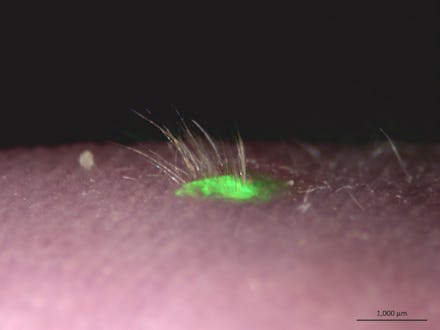This Is the Most Realistic Lab-Grown Skin Ever Created

For the first time, a lab in Japan has grown skin that does more than feel — it sweats, self-lubricates and even grows hair. It could change everything from chemical testing on animals to skin grafts on burn victims — and you don't even have to steal skin from your butt to use it.
Skin substitutes already exist and are used to treat burn patients. But they don't function like normal tissue. On Friday, Dr. Takashi Tsuji of the RIKEN Center for Developmental Biology in Japan, and collaborators at Tokyo University of Science, announced the successful growth of complex skin tissue that had skin appendage organs like hair follicles, sebaceous glands and sweat glands — making it stinky and greasy, just like the natural stuff.
Taking induced pluripotent stem cells grown from one mouse and transplanting them into the skin tissue of another, the bioengineered skin "could be properly connected to surrounding host tissues, such as the epidermis, arrector pili muscles and nerve fibers," without turning into cancer cells, Tsuji said in an email on Friday. Tsuji said the hair even kept growing 70 days after transplant, without any real differences between the bio skin's hair growth and the real deal.
"Some of the [skin substitute] products that are out now have problems with elasticity, moisturizing and temperature control," Candyce Kuehn, clinical nursing supervisor for the Burn Center of Regions Hospital in St. Paul, Minnesota, said over the phone on Friday. "If there's something that is more like our human skin response, that would be huge."
The main problem with traditional skin grafts, Kuehn said, is how much of a step backward in healing you take when borrowing skin from somewhere else on the body.
"Say your burn victim has a 30% burn surface area," Kuehn said. "You're going to take from a donor site ... that's an additional 15%. For a window of time, that person has a 45% burn surface area. But if you don't have to create a donor site, you could get the patient recovered and out of the hospital quicker."
But this isn't just a new regenerative treatment for patients with burns, scars or alopecia. It could mean growing new organs right in the lab, offering an alternative for animal testing.
"Further optimization of our technique using in vitro stem cell culture and humanization will contribute to the development of the therapy by using [the] bioengineered integumentary organ system as a prominent class of organ system replacement regenerative therapy," Tsuji said.
However, like with most exciting science news, we're still talking about rodent transplants; human cells haven't been brought into the mix yet. Optimistically, Tsuji said, they're looking at sometime in the next 10 years. But this could completely change how skin grafts, growing organs and chemical testing are handled. And it all starts with a sweaty patch of pseudo-skin.